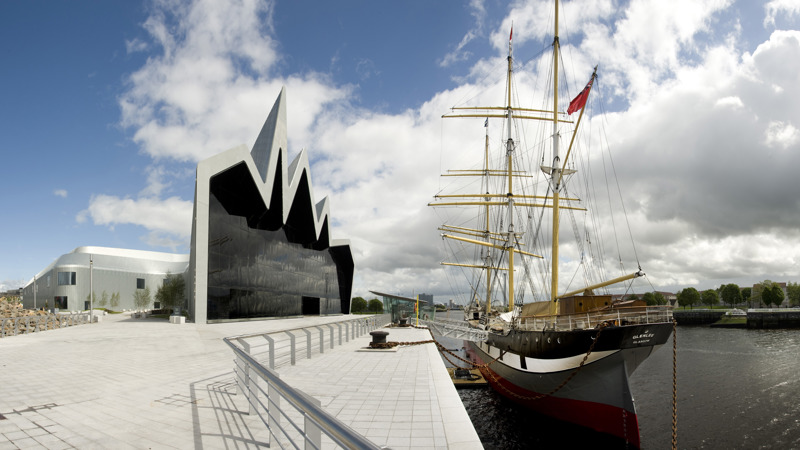Introduction
The Riverside Museum of Transport and Travel, located on the banks of the River Clyde in Glasgow, Scotland, is one of the city’s most visited and beloved museums. Opened in 2011, it replaced the Glasgow Museum of Transport, which was previously housed at the Kelvin Hall. The museum is home to over 3,000 exhibits, celebrating Glasgow’s rich history of transport, engineering, and innovation. Designed by the internationally acclaimed architect Zaha Hadid, the building itself is an architectural masterpiece that complements the city’s evolving urban landscape.
History and Architecture
The Riverside Museum was developed as part of Glasgow’s Clyde Waterfront Regeneration Project, with the goal of revitalizing the former industrial docklands and creating a space that reflects the city’s maritime and transport heritage.
Zaha Hadid’s Architectural Vision
Designed by Zaha Hadid, the Riverside Museum is one of the most striking modern buildings in Scotland. The design features a zig-zagging roofline, meant to symbolize the movement of Glasgow’s transport history while also reflecting the dynamic nature of the River Clyde. The museum’s glass façade and wave-like structure create a seamless transition between the city and the river, paying homage to Glasgow’s shipbuilding legacy.
Exhibitions and Collections
The Riverside Museum houses an impressive array of transport-related artifacts, ranging from locomotives and vintage cars to bicycles, trams, and maritime vessels. The exhibits are arranged in an interactive and engaging manner, allowing visitors to explore Glasgow’s transport evolution across different periods.
Rail and Locomotive Heritage
Glasgow was once home to some of the world’s most significant locomotive manufacturers, including North British Locomotive Company and Andrew Barclay & Sons. The museum features a collection of historic steam and diesel locomotives, highlighting Scotland’s role in railway engineering. Some notable exhibits include:
- The ‘Glen Douglas’ Steam Locomotive, which operated in the early 20th century.
- A restored Subway car from the Glasgow Underground, showcasing how public transport evolved in the city.
- Model railway displays, illustrating the expansion of the British railway network.
Vintage Automobiles and Bicycles
The museum offers an extensive automobile collection, featuring classic cars that showcase the evolution of vehicle manufacturing. Highlights include:
- The Hillman Imp, which was produced in Scotland’s Linwood car plant.
- The 1910 Argyle car, representing early Scottish automotive craftsmanship.
- A diverse bicycle collection, including the famous Penny Farthing and modern racing bikes.
Trams and Buses
Glasgow’s public transport system played a crucial role in shaping the city’s expansion. The museum showcases original Glasgow trams, including:
- A 1930s Glasgow Corporation Tram, which once transported thousands of passengers daily.
- Double-decker buses, reflecting the progression of public transport in Scotland.
Maritime and Shipbuilding Legacy
Glasgow was once a global center for shipbuilding, with famous shipyards along the River Clyde producing some of the world’s most renowned vessels. The Riverside Museum pays tribute to this legacy with exhibits on:
- The Clyde-built Tall Ship SV Glenlee, a fully restored 19th-century sailing ship moored outside the museum.
- Ship models and artifacts, illustrating the craftsmanship of Clyde shipbuilders.
- Nautical instruments and engineering displays, offering insight into marine navigation and ship design.
The Motorbike Collection
For motorbike enthusiasts, the Riverside Museum boasts a fascinating collection of classic motorcycles, including:
- The 1929 Scott Flying Squirrel, known for its innovative engineering.
- A variety of British, American, and European motorbikes, showcasing the development of motorcycling culture.
Interactive Displays and Visitor Experience
One of the unique aspects of the Riverside Museum is its emphasis on interactive and immersive experiences. Visitors can:
- Step aboard historic trams, trains, and buses, experiencing what travel was like in past decades.
- Explore recreated street scenes, depicting life in Glasgow during different eras.
- Engage with digital touchscreens, providing detailed information about each exhibit.
- Enjoy family-friendly activities, including educational programs and hands-on learning opportunities.
The Tall Ship Glenlee
Moored directly outside the Riverside Museum is the Tall Ship Glenlee, one of the last remaining Clyde-built sailing ships. Originally launched in 1896, the Glenlee has been meticulously restored and serves as an additional exhibit where visitors can:
- Explore the ship’s decks and crew quarters.
- Learn about maritime history and the ship’s global voyages.
- Participate in special events and workshops held on board.
Events and Community Engagement
The Riverside Museum hosts a range of temporary exhibitions, talks, and workshops throughout the year. It also plays an important role in community engagement, offering:
- STEM workshops to inspire young minds in science, technology, engineering, and mathematics.
- Heritage days, celebrating Glasgow’s history with guest lectures and special tours.
- Vintage vehicle parades and classic car shows, attracting enthusiasts from across the UK.
Awards and Recognition
Since its opening, the Riverside Museum has received numerous awards, including:
- The European Museum of the Year Award (2013) for its innovative design and visitor engagement.
- The Micheletti Award for best science and industrial museum.
- Consistently high visitor ratings, making it one of Scotland’s top attractions.
The Role of the Museum in Glasgow’s Identity
The Riverside Museum is not just a repository of artifacts; it is a living tribute to Glasgow’s industrial and transport history. It celebrates the city’s contributions to global innovation and serves as a reminder of the hard work and ingenuity of its people. As part of the revitalization of the River Clyde, the museum has helped transform the area into a vibrant cultural hub, attracting tourists and locals alike.
Conclusion
The Riverside Museum of Transport and Travel is a must-visit destination for anyone interested in history, engineering, and transportation. With its stunning architecture, interactive exhibits, and diverse collections, it offers an engaging and educational experience for visitors of all ages. Whether you are fascinated by vintage cars, maritime history, or locomotives, the Riverside Museum provides a unique glimpse into Glasgow’s industrial past and its impact on the modern world.

